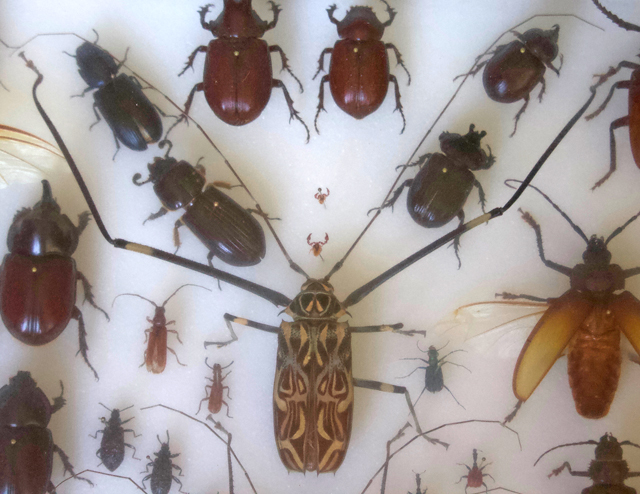


EXCELLENT!!!!
The photo in the Insect/Invertebrate ID topic of the roach w/ its passengers reminded me of the interesting beetle in my collection that had its own passengers. The 3 beetles in the center are harlequin beetles collected in Mexico, and the two tiny insects between the top ones antennae are the pseudoscorpions.


(No, I haven’t collected insects in YEARS,


having traded my net for a camera.

)
Here’s more info:
Without wings, smaller terrestrial animals are really restricted when it comes to moving long distances to find new areas of habitat. However, lots of species get around this problem simply by clinging on to other, more mobile animals. The common, yet overlooked pseudoscorpions are among the most accomplished stowaways, one of which (Cordylochernes scorpiodes) has forged a fascinating relationship with the harlequin beetle, a large, strikingly colored insect.
This story begins on a dead fig tree. Inside these trees, the larvae of the harlequin beetle feed on the decaying wood. Scuttling around on the tree are pseudoscorpions feeding on other small arthropods which they dispatch with their venom-dispensing pincers. These arachnids are most at home in newly decaying trees and after a while their habitat usually becomes less suitable.The harlequin beetle larvae have completed their development and are ready to emerge as adults from the tree. As soon as an adult beetle has fully emerged from its larval tunnel, the pseudoscorpions gather around its rear end and nip its abdomen with their pincers. Annoyed by these pinches, the beetle flexes it abdomen, making enough space beneath its elytra and wings for the little arachnids to jump aboard. Not all the pseudoscorpions freely embark. One of the larger male pseudoscorpions will prevent other males from boarding the beetle, but will happily allow females on, in the hope of mating with them before they reach their destination.
The beetle takes off from the tree that nurtured it, along with its arachnid stowaways. Eventually, the beetle will land on a suitable, newly decayed tree and the female passengers will disembark. But the large, male pseudoscorpion may remain aboard its beetle for as long as two weeks in the event of more females clambering aboard when it touches down elsewhere. These long-term passengers don’t want to fall off prematurely so they spin silken ‘safety harnesses’ that eventually become little nest-like structures. They even use a silken thread to descend from their beetle and may even use this line as a means of re-boarding the transport if they need to.
The larger, bullying males who monopolized the beetle transport (and the females) do not get everything their own way. They will not father all of the resulting offspring because the females store sperm from previous matings.
https://news.mongabay.com/2014/03/wonde ... -arachnid/

